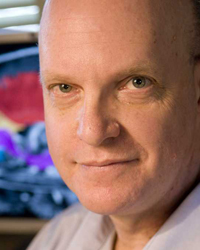
|
|
HUMAN MEDIA INTERACTION : SEEING AND THE BRAIN 
Brian Wandell Stein Family Professor Psychology · Electrical Engineering (by courtesy), Stanford University. Location: Gold Hall Date & Time: Monday, September 12, 09:00-10:00 Abstract: For the past twenty-five years scientists and engineers have collaborated on a wide variety of hardware and image processing methods to better image and understand the brain. These technologies have clarified structures and functions over an enormous range of spatial and temporal scales, from molecules to whole brain. One of the important technologies is magnetic resonance imaging (MRI), which is a non-invasive means for measuring both activity and structure in the living human brain. Many of the achievements in human neuroimaging with MRI can be traced to advances in image and signal processing. I will review some advances in human neuroimaging using the visual pathways, my own research area, as an example system. While most of the human visual pathways were inaccessible to measurement thirty years ago, today we can place a subject in an MR scanner and measure fifteen visual field maps and identify the white matter pathways in experiments requiring only forty-five minutes. These measurements enable us to track brain activity as children learn to see words, or as people perceive motion, color and form. While we have learned a great deal from these technologies, most MRI measurements produce images without units, and these are analyzed qualitatively or relative to arbitrary baselines. In the next phase of human neuroimaging we will need to create image processing tools that are coupled to biological quantities by models. The generic image processing methods we use now will be replaced by methods that are based on physical models of the measurement instrument and tissue properties. The quantitative image processing may enable us to learn about properties of biological tissue and expand our understanding of brain in health and disease. Joint work with Michal Ben-Shachar, Alyssa Brewer, Robert Dougherty, Kendrick Kay, Aviv Mezer, L. Michael Perry, Jon Winawer, and Jason Yeatman Biography: Brian A. Wandell is the first Isaac and Madeline Stein Family Professor. He joined the Stanford Psychology faculty in 1979 and is a member, by courtesy, of Electrical Engineering, Ophthalmology, and Radiology. Wandell is Director of the center of Cognitive and Neurobiological Imaging (CNI). His research projects center on how we see, spanning topics from visual disorders, reading development in children, to digital imaging devices and algorithms. Educational background. Wandell graduated from the University of Michigan in 1973 with a B.S. in mathematics and psychology. In 1977, he earned a Ph.D. in social science from the University of California at Irvine. After a year as a postdoctoral fellow at the University of Pennsylvania, he joined the faculty of Stanford University in 1979. Professor Wandell was promoted to associate professor with tenure in 1984 and became a full professor in 1988. Neuroscience Wandell's work in visual neuroscience uses functional and structural MRI along with behavior testing and modeling to understand the action of the visual portions of the brain. His research includes studies of the organization of the visual field maps in the human brain, color and motion processing within these maps, and the potential for reorganization following injury or developmental disorders. The Wandell lab develops tools for diffusion imaging and functional MRI. Recent years they have carried out a series of studies on brain plasticity and development. In one example, they are carrying out a longitudinal study measuring the development of structures and signals in visual cortex in children, aged 8-12, as they become skilled readers. The lab's measurements of developmental changes during the acquisition of skilled reading are intended to understand how visual signals become rapidly identified and classified in the process of learning to read. Digital imaging. Brian Wandell's research includes image system engineering and visual neuroscience. In cooperation with Professor Emeritus Joseph Goodman (a faculty member in Stanford's School of Engineering), Professor Wandell founded the university's Stanford Center for Image Systems Engineering Program. As part of this research, Wandell and his team study and build devices used for digital imaging, including image sensors, high dynamic range displays, and software simulations of the digital imaging pipeline. Teaching. Brian Wandell's teaching at Stanford reflects his multiple areas of expertise. He has taught courses on behavior, perception, cognitive and behavioral neuroscience, image systems and computational He has also led classes on color science and computer applications for engineers and managers from more than 200 companies. In addition to numerous scientific articles, Brian Wandell is the author of the vision science textbook Foundations of Vision. He is an associate editor of the Journal of Vision, the Journal of Neuroscience and Neural Networks. He has served as a consultant and technical advisor for a number of corporations and has patented some of the products of his work. Awards:
In 1986, Wandell won the Troland Research Award from the National Academy of Sciences for his work in color vision. He was made a fellow of the Optical Society of America in 1990; in 1997 he became a McKnight Senior Investigator and received the Edridge Green Medal in Ophthalmology for work in visual neuroscience. In 2000, he was awarded the Macbeth Prize from the Inter-Society Color Council, and in 2007 he was named Electronic Imaging Scientist of the Year by the SPIE/IS&T, and he was awarded the Tillyer Prize from the Optical Society of America in 2008. Wandell was elected to the US National Academy of Sciences in 2003. |
©2011 UCL/TELE || icip2011-webmaster@listes.uclouvain.be || Last updated September 06, 2010, at 03:01 PM